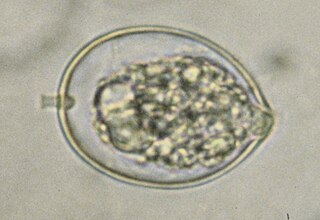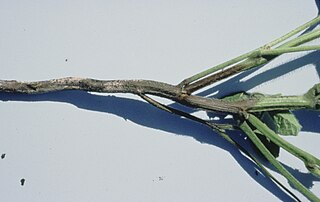Related Research Articles

Phytophthora is a genus of plant-damaging oomycetes, whose member species are capable of causing enormous economic losses on crops worldwide, as well as environmental damage in natural ecosystems. The cell wall of Phytophthora is made up of cellulose. The genus was first described by Heinrich Anton de Bary in 1875. Approximately 210 species have been described, although 100–500 undiscovered Phytophthora species are estimated to exist.

Phytophthora cinnamomi, also known as cinnamon fungus, is a soil-borne water mould that produces an infection which causes a condition in plants variously called "dieback", "root rot", or, "ink disease".
Root rot is a condition in which anoxic conditions in the soil or potting media around the roots of a plant cause them to rot. This occurs due to excessive standing water around the roots. It is found in both indoor and outdoor plants, although it is more common in indoor plants due to overwatering, heavy potting media, or containers with poor drainage. The leaves of plants experiencing root rot often yellow and die, and if allowed to continue, the condition can be fatal.
Phytophthora sojae is an oomycete and a soil-borne plant pathogen that causes stem and root rot of soybean. This is a prevalent disease in most soybean growing regions, and a major cause of crop loss. In wet conditions the pathogen produces zoospores that move in water and are attracted to soybean roots. Zoospores can attach to roots, germinate, and infect the plant tissues. Diseased roots develop lesions that may spread up the stem and eventually kill the entire plant. Phytophthora sojae also produces oospores that can remain dormant in the soil over the winter, or longer, and germinate when conditions are favourable. Oospores may also be spread by animals or machinery.

Phytophthora palmivora is an oomycete that causes bud-rot of palms, fruit-rot or kole-roga of coconut and areca nut. These are among the most serious diseases caused by fungi and moulds in South India. It occurs almost every year in Malnad, Mysore, North & South Kanara, Malabar and other areas. Similar diseases of palms are also known to occur in Sri Lanka, Mauritius, and Sumatra. The causative organism was first identified as P. palmivora by Edwin John Butler in 1917.
Aphanomyces euteiches is a water mould, or oomycete, plant pathogen responsible for the disease Aphanomyces root rot. The species Aphanomyces euteiches can infect a variety of legumes. Symptoms of the disease can differ among hosts but generally include reduced root volume and function, leading to stunting and chlorotic foliage. Aphanomyces root rot is an important agricultural disease in the United States, Europe, Australia, New Zealand, and Japan. Management includes using resistant crop varieties and having good soil drainage, as well as testing soil for the pathogen to avoid infected fields.

Thielaviopsis basicola is the plant-pathogen fungus responsible for black root rot disease. This particular disease has a large host range, affecting woody ornamentals, herbaceous ornamentals, agronomic crops, and even vegetable crops. Examples of susceptible hosts include petunia, pansy, poinsettia, tobacco, cotton, carrot, lettuce, tomato, and others. Symptoms of this disease resemble nutrient deficiency but are truly a result of the decaying root systems of plants. Common symptoms include chlorotic lower foliage, yellowing of plant, stunting or wilting, and black lesions along the roots. The lesions along the roots may appear red at first, getting darker and turning black as the disease progresses. Black root lesions that begin in the middle of a root can also spread further along the roots in either direction. Due to the nature of the pathogen, the disease can easily be identified by the black lesions along the roots, especially when compared to healthy roots. The black lesions that appear along the roots are a result of the formation of chlamydospores, resting spores of the fungus that contribute to its pathogenicity. The chlamydospores are a dark brown-black color and cause the "discoloration" of the roots when they are produced in large amounts.
Leptosphaeria pratensis is a plant pathogen. It causes stagonospora root rot.

Phytophthora cactorum is a fungal-like plant pathogen belonging to the Oomycota phylum. It is the causal agent of root rot on rhododendron and many other species, as well as leather rot of strawberries.

Phytophthora medicaginis is an oomycete plant pathogen that causes root rot in alfalfa and chickpea. It is a major disease of these plants and is found wherever they are grown. P. medicaginis causes failure of stand establishment because of seedling death. Phytophthora medicaginis is part of a species complex with Phytophthora megasperma.

Phytophthora megasperma is a species of water mould in the family Peronosporaceae. It is well known as a plant pathogen with many hosts. It often causes a plant disease called root rot.
Nectria radicicola is a plant pathogen that is the causal agent of root rot and rusty root. Substrates include ginseng and Narcissus. It is also implicated in the black foot disease of grapevine. It is of the genus Nectria and the family Nectriaceae. N. radicicola is recognizable due to its unique anatomy, morphology, and the formation of its anamorph Cylindrocarpon desructans.
Calonectria ilicicola is a fungal plant pathogen in the family Nectriaceae. It has been found to cause leaf spot in holly, root rot in blueberry, red crown rot in soybean, a root and crown rot of anthurium, and a soft rot of ginger.

Phytophthora capsici is an oomycete plant pathogen that causes blight and fruit rot of peppers and other important commercial crops. It was first described by L. Leonian at the New Mexico State University Agricultural Experiment Station in Las Cruces in 1922 on a crop of chili peppers. In 1967, a study by M. M. Satour and E. E. Butler found 45 species of cultivated plants and weeds susceptible to P. capsici In Greek, Phytophthora capsici means "plant destroyer of capsicums". P. capsici has a wide range of hosts including members of the families Solanaceae and Cucurbitaceae as well as Fabaceae.

Phellinus weirii is a species of fungus. It is the plant pathogen that causes laminated root rot in certain conifers, typically Douglas-fir and western redcedar. It is widespread in the Douglas-fir growing regions of British Columbia, Washington and Oregon.
Heterodera medicaginis, the alfalfa cyst nematode, is a plant pathogenic nematode which is cited as an invasive species. It is closely allied to Heterodera daverti, H. glycines and H. sonchophila in the H. schachtii-group. The only known host plant of this obligate parasite is the important crop alfalfa or lucerne, Medicago sativa.
A root crown, also known as the root collar or root neck, is that part of a root system from which a stem arises. Since roots and stems have quite different vascular anatomies, major vascular changes take place at this point.

Spring Black Stem is a common fungal, foliar disease caused by Ascochyta medicaginicola. Spring Black Stem is most commonly found in alfalfa, but also attacks certain clovers. The fungus survives in stubble from previous cuttings and spreads easily by rain splash, running water, and equipment. The disease is present in numerous alfalfa fields throughout the Northeast United States.
Acrocalymma is a fungal genus in the family Lophiostomataceae. It was circumscribed in 1987 by Australian botanists John L. Alcorn and John Irwin to contain the species A. medicaginis, found to cause crown and root disease of alfalfa. The genus name is derived from the Ancient Greek words acros and calymma ("hood"). Acrocalymma aquatica, discovered in northern Thailand, was added to the genus in 2012.

Collar rot is a symptomatically described disease that is usually caused by any one of various fungal and oomycete plant pathogens. It is present where the pathogen causes a lesion localized at or about the collet between the stem and the root. The lesions develop around the stem eventually forming a "collar". Observationally, collar rot grades into "basal stem rot", and with some pathogens is the first phase of "basal stem rot" often followed by "root rot". Collar rot is most often observed in seedings grown in infected soil. The pathogens that cause collar rot may be species or genera specific. But generalist pathogens such as Agroathelia rolfsii are known to attack over 200 different species. While bacteria caused collar rot is not common, trees infected with Fire blight may develop collar rot. Non-parasitic collar rot may be caused by winter damage.
References
- ↑ Alcorn JL, Irwin JAG. (1987). "Acrocalymma medicaginis gen. et sp.nov. causing root and crown rot of Medigo sativa in Australia". Transactions of the British Mycological Society. 88 (2): 163–7. doi:10.1016/s0007-1536(87)80211-5.